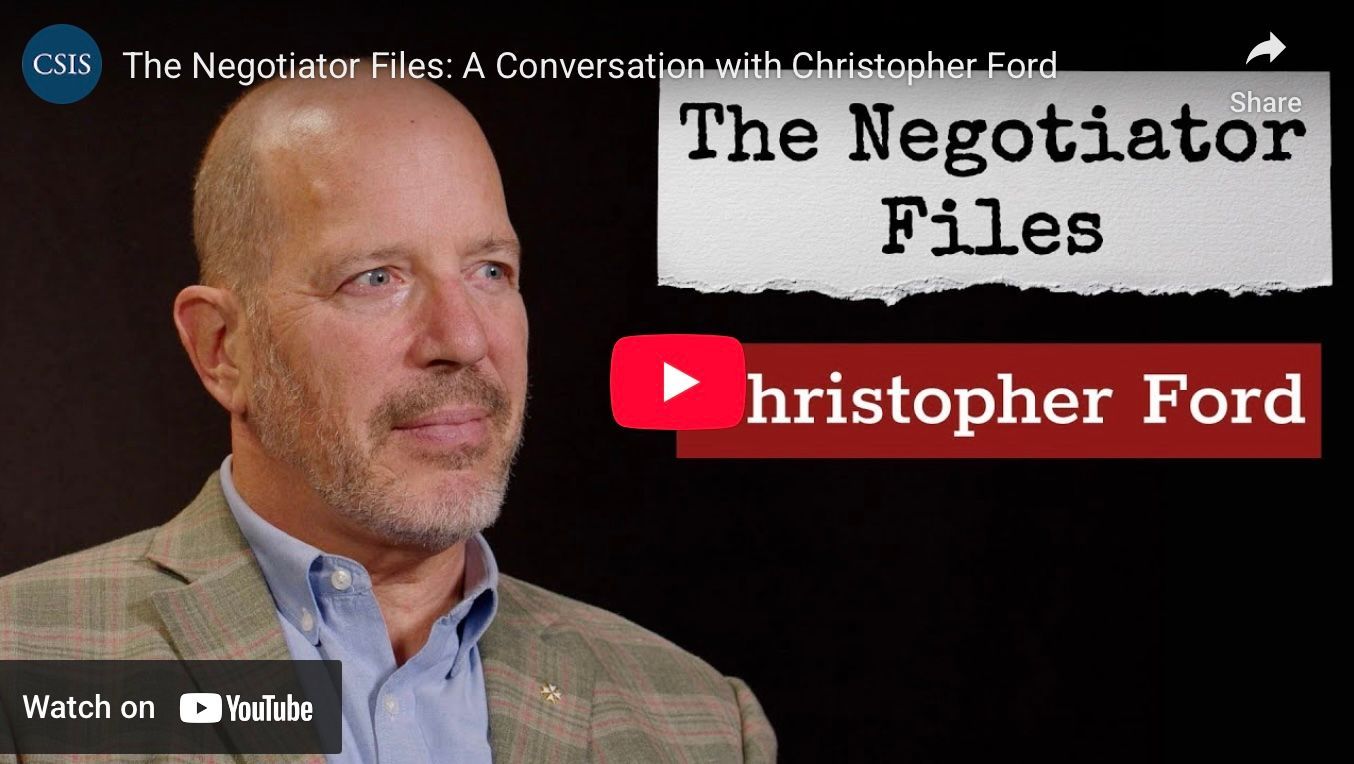Thinking About the Next Nuclear Posture Review
Below are the remarks Dr. Ford prepared for a November 22, 2021, meeting at the Pentagon of the "External Roundtable" for the Biden Administration’s 2021 Nuclear Posture Review.
I’m pleased to be able to take part in this roundtable discussion today, and I commend the Biden Administration for its willingness to listen to outside voices such as mine as it considers what to say in its forthcoming 2021 Nuclear Posture Review (NPR).
Nuclear weapons posture is one of those topics where the people most knowledgeable about and most interested in the question tend to have positions that are deeply dug in, and have been so for a long time, and views can thus be very hard to sway here. That’s both a curse and a blessing, however, for this is also an area where – despite periodic changes of the rhetorical wrapping, as it were – there has been a remarkable amount of continuity in U.S. policy over time, despite the inherently controversial nature of this subject matter.
That continuity is a real strength for our country, I think, especially in an era of heightening great power competition in which we rather badly need our adversaries to understand that the United States really is in this for the long haul. After all, they must not think they can “wait us out” en route to some sort of eventual U.S. strategic capitulation, or that they can rely for their own competitive strategic advantage on America suffering self-inflicted wounds out of one type or another of politically-driven policy enthusiasm in Washington. Continuity over time, and bipartisan support for U.S. nuclear strategy, helps prevent this.
So I suppose my first point is just to draw attention the strength that comes from such continuity of focus and such steadiness of purpose over time. Whether the harm comes from the Right or from the Left, we squander that strength at our peril.
I. Integrated Deterrence
In that vein, therefore, let me first say a word about “integrated deterrence,” which seems to be the strategic phrase or buzzword du jour. Frankly, it’s a bit hard to know what to make of the idea at this point.
There’s nothing wrong with each U.S. Presidential Administration doing a bit of rebranding in order to put its stamp on, and lay some special individual claim to, sensible policies. And it’s perfectly fine, of course, to adjust approaches as needed in light of changed circumstances or improved knowledge.
In the Trump Administration, for instance, we applauded the Obama Administration’s insight in the 2010 Nuclear Posture Review that evolving technologies such as biological weaponry could conceivably present a strategic threat that might not be deterrable with conventional capabilities alone. So we took that insight and sharpened it into the 2018 NPR’s concept of a “significant non-nuclear strategic attack,” making clear that to the degree that any such threat in the hands of a state-level adversary reached a sufficiently grave level, this might need to fall within the ambit of U.S. nuclear declaratory policy.
In light of where even the unclassified reporting has come since then, I’m glad we did that. In recent years, after all, we’ve seen public revelations about Russia’s retention and continued development of both a chemical weapons and a biological weapons program, as well as continuing concerns about China’s potential biological weapons capabilities. We’ve seen evidence that Russia is testing space-based weapons in orbit that could be used to threaten space-based U.S. nuclear command-and-control assets. And we’ve seen U.S. intelligence assessments that Russian cyber-warriors are “mapping” U.S. civilian critical infrastructure in order potentially to take down our electricity grid, water supply, and other essential services on a mass scale in the event of conflict. Thanks to the COVID-19 pandemic, moreover, we also now have a much clearer picture of the sort of mayhem that a biological weapons capability could really create.
Thinking about how to reduce risk, manage competition, and deter aggression along all these axes – and to integrate a wide variety of possible “fires,” if you will, in the service of such deterrence – is complicated as hell. On the higher end of potential strategic impact, there cannot but be at least some nuclear implications.
So I think that approach of integrating cross-domain concepts and dynamics into U.S. nuclear declaratory policy in 2010 and in 2018 was clearly necessary. It also represents an important case study in the bipartisan evolution of U.S. deterrence strategy in response to the development of emerging technologies with potential strategic impact and changes in novel “battlespace” domains.
“Integrated deterrence,” therefore, as announced by Secretary of Defense Austin on April 30, 2021, could be a way of pointing out that many factors go into deterring aggression against the United States and our allies and partners. And it could be a way of saying that we should attend to as many of these factors as we can, and through a carefully-thought-out intellectual framework that recognizes the importance and complexity of cross-domain dynamics and seeks to combine and coordinate the various levers of power as effectively as possible.
If “integrated deterrence” means commonsensical things like that, there will be little to disagree with. And nuclear deterrence will clearly need to be fit into such a framework, even while we also do more to think through how to approach deterrence, risk-management, and potential warfighting concepts within and between novel domains such as outer space and the sprawling and variegated breadth of the cyber and information domain.
On the other hand, there would be reason to complain if talk of “integrated deterrence” is used as an excuse to downplay or back away from some elements of our overall deterrence mix in order to scratch some ideological itch. It would be notably problematic, for instance, were we to rationalize indulging a politically-driven “no first use” or “sole purpose” nuclear weapons agenda – a declaratory policy that our adversaries would not credit, but that would nonetheless undermine our allies’ faith in the “nuclear umbrella” that helps protect them against conventional military aggression by Russia or China – by pretending that we will magically make up for forswearing much of that “umbrella” through the cleverer “integration” of diplomacy and unspecified other tools into our posture. We need to work with our friends and allies against the revisionist authoritarians, after all, not risk sacrificing them on the altar of anti-nuclear virtue-signaling!
So I don’t really know what “integrated deterrence” means yet. But I hope that President Biden will listen thoughtfully to his national security professionals in the NPR process as Presidents Obama and Trump actually both did before him.
II. Nuclear Posture and Arms Control
But I suspect they really asked me here to talk about arms control rather than integrated deterrence. Accordingly, let me offer some brief comments about how I think it may be helpful for the United States to approach the NPR process from the perspective of negotiating future arms limitation or perhaps even reduction agreements with Russia and with China. I made some of these points in more detail in to a CSIS event in September, the text of which I posted on my New Paradigms Forum website, so I won’t belabor them here. But here are my quick thoughts:
- First, in whatever discussion of arms control it contains, the NPR should make clear that arms control is an American objective only to the extent it will contribute to U.S. security and to international peace and security. Arms control isn’t a goal in itself, and the Administration should make clear that we do not seek agreements for their own sake, but rather to make our country and the world safer. If we want success in the difficult business of arms control negotiation, the other side needs to know we’re in this for improved security and not simply acting out of political desperation for some agreement, any agreement. As the saying goes, “If you want it bad, you get it bad,” and we won’t be taken seriously at the negotiating table unless we act serious. The NPR is the Biden Administration’s first and best chance to signal that seriousness of security-focused purpose.
- Second, completing the modernization the U.S. nuclear arsenal in order to replace aging legacy systems with ones that will remain useful, safe, and reliable for as long as we need them is absolutely essential to finding a successful way forward in the arms control arena. If we hope to bargain with other possessors over restraints upon or reductions in their nuclear arsenals, we need to have something to bargain with. Unless we wish to disarm ourselves unilaterally – thus doing the work of Russian and Chinese nuclear negotiators for them, and without getting anything in return – there is no alternative to completing our current modernization.
- We should, moreover, complete this modernization in its entirety. I understand that it might feel politically satisfying to tell disarmament advocates that we are working to keep the global disarmament agenda moving by once again trying to “set an example” in scrapping capabilities unilaterally in ways we’ve sadly learned our adversaries won’t actually follow. From the perspective of negotiating effective arms control agreements, however, doing so would basically be – to use the technical term – nuts. As I pointed out to CSIS, even if President Biden does not actually like all of the current suite of deterrence-promoting U.S. capabilities, or perhaps especially if it doesn’t like some of them, it would be arms control malpractice to abandon them unilaterally. Why would any of our strategic adversaries negotiate limits or reductions with us when we’re busy throwing out our own weaponry at no cost to them?
- Finally, if we value the ability of arms control to contribute to our security and that of our allies, we also have work to do in modernizing our nuclear weapons infrastructure – that is, the “non-sexy” but absolutely essential, sine qua non component of U.S. nuclear deterrence that most people tend to forget about, and that we’ve had such difficulty properly capitalizing for a full generation. As I put it in a paper last year,
“Having a robust and effective nuclear weapons infrastructure is vital if one is to maintain any meaningful deterrence over time, and it is also of enormous importance in deterring ‘breakout’ from arms control agreements and in avoiding the dangerous spiral of an unconstrained nuclear arms race. Your adversary, for instance, does not need to know only that your existing weapons will ensure that aggression would exact from him an entirely unacceptable cost. That adversary also needs to know that you can keep him in this position of being deterred for as long as you need to, regardless of what he does. And this is the role of the nuclear weapons development and production infrastructure: a robust infrastructure tells the adversary that he cannot out-build and overwhelm you in an arms race. Maintaining such an infrastructure thus contributes both to baseline deterrence and to preventing treaty ‘breakout’ and arms racing.”
Having such an infrastructure is thus essential, but we’ve been falling down on the job for decades in this respect, and we are still short of what we would need to have to convince Moscow and Beijing to do anything other than sneer at our capability to compete with them over the long term without an arms agreement. So if we really want arms control, it’s time to get serious about ensuring that America has the robust, resilient, and responsive nuclear weapons infrastructure for which its own national security planners have been calling for decades – but that its most senior leaders and its Congressional appropriators for far too long neglected.
III. Conclusion
That’s probably plenty to chew on for now, so let me conclude just by stressing one thing. We need to put entirely behind us the simplistic and incorrect reflexive assumption that in a world of escalating strategic challenges – among them China’s shocking and deeply provocative nuclear build-up and the evolution of multiple cross-domain threats with potential strategic impact – there exists some kind of inherent tension between (1) the United States having a robust nuclear deterrence and “extended” deterrence posture and (2) our good faith desire and efforts to negotiate effective new arms control frameworks and try to move forward in some fashion toward the eventual dream of a world safely and stably rid of nuclear weapons.
Simply put, there is no necessary tension between those objectives. If anything, in fact, the first is an enabler and precondition for the second, and if we pretend that there is such a tension we are likely to fail at achieving them both.
Thanks for listening.
-- Christopher Ford









